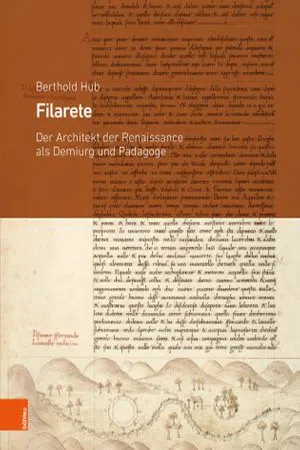
Filarete : Der Architekt der Renaissance als Demiurg und Pädagoge
- English
- PDF
- Available on iOS & Android
Filarete : Der Architekt der Renaissance als Demiurg und Pädagoge
About this book
Antonio di Pietro Averlino, called Filarete, in his Libro architettonico, written between 1460 and 1464 in the form of a dialogue between the author and Duke Francesco Sforza and his son Galeazzo Maria Sforza, tells of the planning, founding and construction of the city named after its owner »Sforzinda« and a city by the sea connected to it. In addition to the practical aspects of architecture and theory in the narrower sense, the first monographical examination of the Codex is also devoted to passages and illustrations that have hitherto been neglected or not at all Filaretes' source writings that go beyond the usual art-historical reference points to show Libro as an outstanding, crystalline document of its time as a whole, which expands and corrects our picture of the Renaissance, shaped by the winners of history.
Frequently asked questions
- Essential is ideal for learners and professionals who enjoy exploring a wide range of subjects. Access the Essential Library with 800,000+ trusted titles and best-sellers across business, personal growth, and the humanities. Includes unlimited reading time and Standard Read Aloud voice.
- Complete: Perfect for advanced learners and researchers needing full, unrestricted access. Unlock 1.4M+ books across hundreds of subjects, including academic and specialized titles. The Complete Plan also includes advanced features like Premium Read Aloud and Research Assistant.
Please note we cannot support devices running on iOS 13 and Android 7 or earlier. Learn more about using the app.
Information
Table of contents
- Filarete
- Inhalt
- Danksagung
- Einleitung
- 1. Leben und Libro
- 2. Ankunft in Utopia
- 3. Der Grundriss der Stadt als Abbild des Kosmos
- 4. Die Gründung der Stadt als Wiederherstellung der Schöpfung
- 5. Erziehung zur Antike
- 6. Renaissance einer prisca architectura
- 7. Erziehung zur Tugend
- 8. Der Architekt und die Bienen
- 9. Der Architekt der Renaissance und die Renaissance des Architekten
- Bibliographie
- Tafelteil
- Verzeichnis der Abbildungen